Reader T. von Rosen writes:
If cars are one of your passions, you know that speed costs money. Likewise, in shooting, accuracy costs money – in ammunition, optics, accessories, and more. The better, more consistent accuracy you want to achieve, the more expensive it will generally be. Given that it takes a big investment in both time and money to determine the best accuracy that your firearm is capable of, let’s look at some key factors you need to consider in your pursuit.
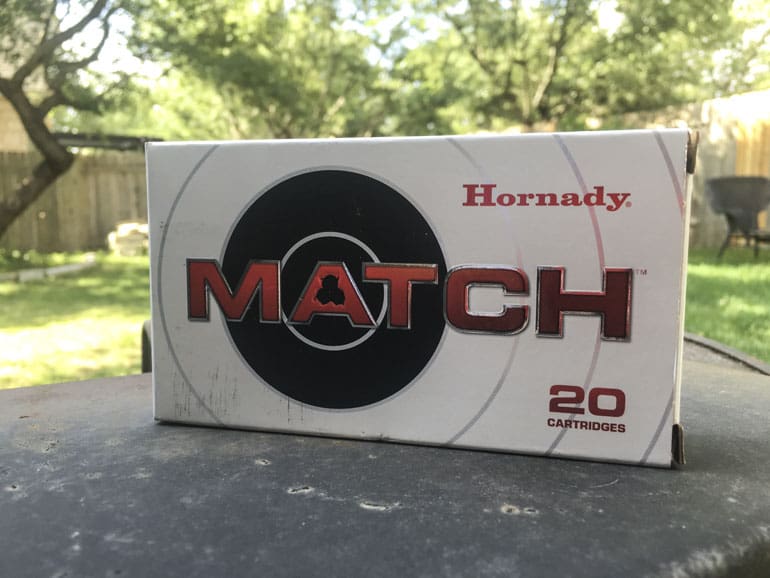
Ammunition
To get the best accuracy of your firearm, you need quality ammunition. That means purchasing match/competition ammunition, not hunting, range or general military surplus loads. Precise match ammunition is made by numerous manufacturers.
You can Google for the top performers, research what the top shooters use (if they use factory ammunition), or just try a selection of whatever is available nearby for purchase. As you probably already know, individual firearms can be finicky about ammo, so you may need to test a variety of brands/loads/bullet weights and styles.
If you handload — and if you’re really serious about accuracy, you eventually will — the good news is that there has never been a better selection of quality match/competition bullets. In no particular order, Sierra, Hornady, Nosler, Lapua, and Speer (among others) all make extremely high-quality projectiles. Better yet (in my experience) are Berger bullets.
Most accurate of all (and most expensive) are small batch custom bullets favored by benchrest shooters, such as Bart’s. Eley and Lapua dominate .22 rimfire competitive shooting, although other brands can also perform well.
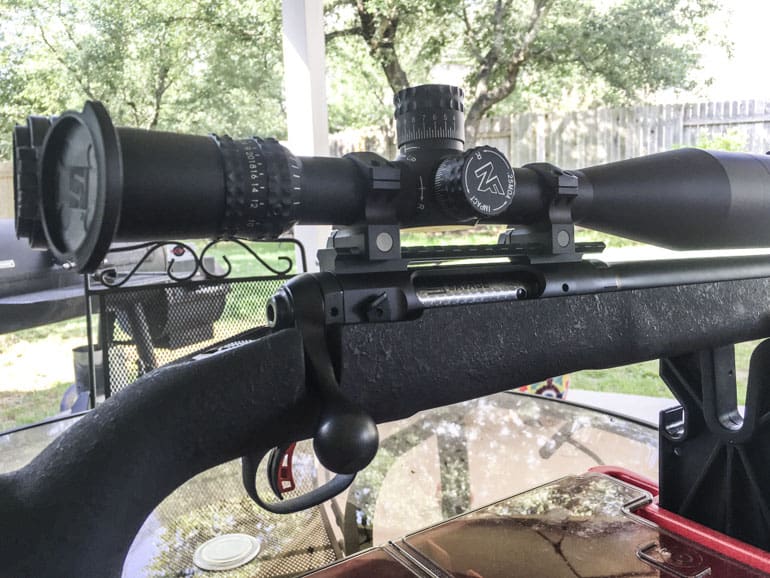
Optics
Can you shoot small groups with a 4-power optic? Yes. Can you shoot small groups with inexpensive optics? Yes. However, if you want to determine the best accuracy that your firearm is capable of, you need top-quality, high-magnification optics. Look at what the best shooters use, save up, and purchase accordingly.
I recommend no less than 12 power, and am more and more inclined to prefer scopes around 20 power, for ranges out to 600 yards or so. Some top brands, in no particular order, are Leupold, Steiner, Sightron, Weaver, Nightforce, and March Optics.
Good glass isn’t cheap. However, buying used optics with top-quality warranties (such as Leupold’s lifetime warranty), is a great way to save some money. You may eventually settle on one scope for all your testing needs, and merely move the scope from gun to gun as needed.

Bench equipment
I do all initial accuracy testing from the bench. That means having certain equipment to ensure the best, most consistent results.
First, you need a quality front rest. Think Sinclair and Caldwell, among others. The best are cast iron (you want the weight for stability), and have windage-adjustable tops.
You’ll want a bubble level for your front rest, and a variety of sand bags of different widths (so you can accommodate various stock widths).
You’ll need a rear sandbag for stability as well. Again, the bags available at your local mass-market discounter won’t cut it. Order from a specialty shop or buy used quality bags from retired benchrest shooters. You’ll want to remove your rifle’s sling and the swivels (these will catch on the bags and throw your shots).
You need to ensure that your rifle is in the exact same position on the bags every time, or as close as possible. I frequently use blue painter’s masking tape to indicate on my stock exactly where it contacts the rear bag. Finally, make sure you have a rock-solid seat or stool.
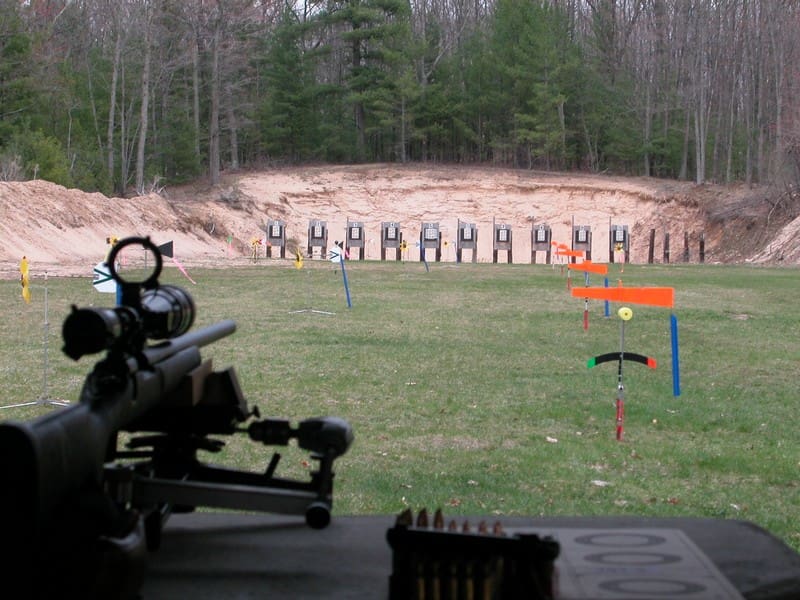
Wind flags
Accuracy testing without wind flags is like peeing into the wind. If I’m testing a sporter (non-competition) rifle, I usually use a foot or two of surveyer’s ribbon, tied to an old camera tripod. I put that at 25 yards (if testing at 100 yards), and fire only when I get the condition I want.
Attaching some surveyer’s ribbon to the target frame can help, too, although knowing what the wind is doing closer to the bench is far more important than knowing what it’s doing at the target. Some folks use simple wooden stakes with ribbon stapled on placed at consistent distances.
For benchrest guns and others capable of extreme accuracy, I bring out the professional wind flags. If flags aren’t your thing, at a minimum you need to memorize indicators of wind speed, such as the wind speed at which tree leaves will rustle. Hand-held electronic wind indicators are (well, can be) excellent. In summary, you need to know what the wind is doing to produce the smallest groups you can.
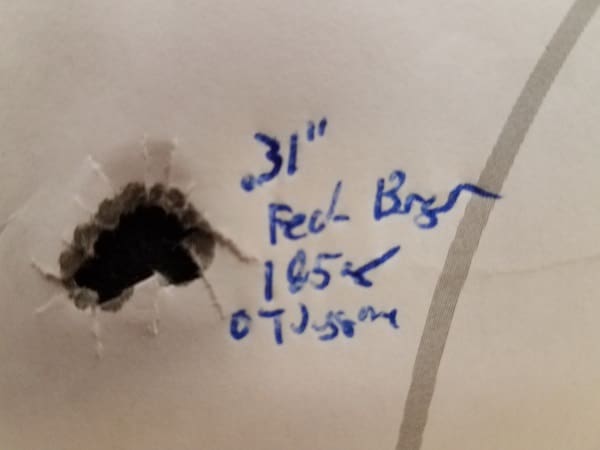
Consistency
Whatever equipment you have, the most important factor in using it is consistency. Whatever you do, you need to do it the exact same way, every time. Whether your front rest is a $1,000 benchrest premium rig, a rice-filled sock or a bipod, set it up with repeatable precision and consistency.
You may be a bag-squeezer or you may hold the forward part of your rifle stock in a death grip. Those are different topics for a different post. However you use your non-primary hand, do it the same way, every time. Put your feet on the ground in the same place for every shot and learn to control your breathing.
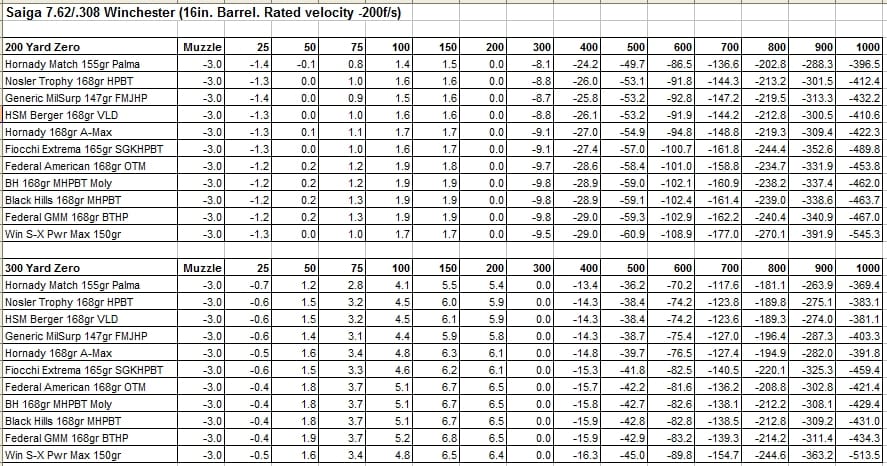
Shortcuts
There is a broad base of knowledge out there that you can leverage to shoot tiny(er) groups with minimal investment. For example, let’s say you’re trying to get a .223/5.56 rifle to shoot better. Thankfully, both Uncle Sam and thousands of competitive shooters have already paved the road for you.
For anything with a 1/9 to a 1/7 barrel twist rate, I’ll select a 50-60 grain match bullet for ranges out to 200 yards. From 200-500 yards, something in the 68-70 grain weight range is perfect. Ranges from 600 yards or more call\ for 75-80 grain bullets (note – the 1/9 barrel probably won’t stabilize bullets of these weights, so you’re likely stuck with using lighter weight options). Nonetheless, if you can’t get small groups with a .223/5.56 at those ranges, with those weights of match bullets, then, son, you’ve got a gun, equipment, or technique issue.
Again, that’s just one example with a few possible options. Your rifle, ammunition and conditions can and will vary. But you can do some homework before you ever get to the range that should let you get closer to the results you want in less time with fewer rounds expended.
Accuracy testing is a time-consuming and expensive pursuit. Frequently, most of us stop either when we achieve a certain level of accuracy (say, one MOA) or when we get tired of sinking so much time and effort trying to achieve that certain desired level of accuracy.
Wherever you stop, while it can be fun, remember that accuracy testing isn’t (for most of us) a sport in and of itself. After all, accuracy testing is just one step in the process. There are hunts to go on, competitions to participate in, and principles of marksmanship to master. Given that none of us have unlimited time and/or funds, a few shortcuts here and there can make a big difference.
Hopefully, the experience I’ve shared above, gained through decades of shooting, can help you to quickly determine the top level of accuracy that you and your firearm can achieve. While it’s true that accuracy costs money (as does speed for your vehicle), a few key purchases – plus some good technique – can bring out the very best in your firearm.

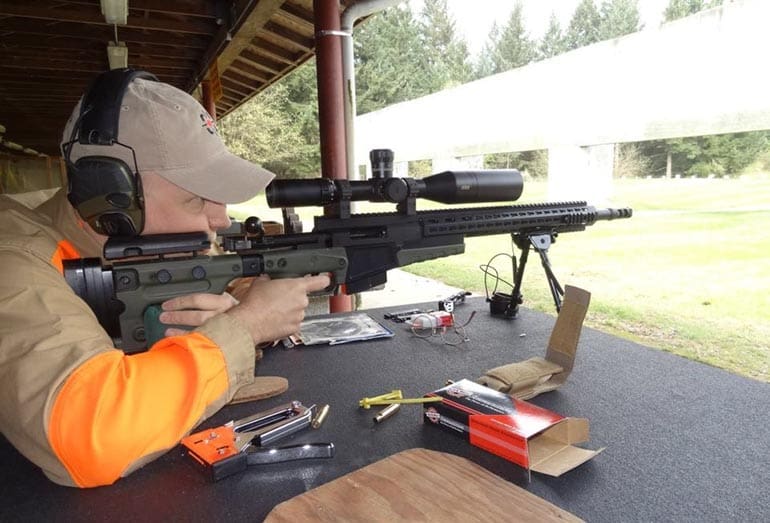



One of the best investments in accuracy that I have made is the Mantis shot analyzer that I purchased. of course, it still requires shooting; but it provided me with constant feedback and scoring, not of the shot, but the form.
I am simply amazed how much better I have gotten with my Glock 42 since I started using it. As a fun break, some others at the range and I have been informally competing for the highest mantis score in a series of shots. A higher score on the device directly corresponds to a higher score on the paper.
No, there are no shortcuts to being a better shooter, but there are things that can make range time more productive. And mixing things up does add to the enjoyment.
Probably the reason that NO US Small Arms Manufacturer has Won a US Military Assault Rifle Contract since 2007! Lack of Accuracy…
Fake news. New Zealand recently selected LMT to supply their rifles.
Good for New Zealand! But I wasn’t talking about New Zealand, was I…
Ah yes, should have read your comment a bit more thoroughly. Beer and posting doesn’t always mix.
As I recall, I clearly stated “[US Military] Assault Rifle Contract”! Where in US Military do you see “New Zealand”? Us you’re “Little Orphan Annie Decoder Ring” if you think that will help…
The biggest difference between cars and guns is that putting money into the car gets more results than putting money into a better gun. Most medium priced guns shoot better than their owners right out of the box.
Absolutely. A relatively cheap Ruger American with a bargain Nikon can outshoot me on my best day.
^^ This.
Spending extraordinary amounts of money on super-sub-MOA accuracy, I would just be massaging my own ego. Although, many people do. I can do the stock gear justice but that’s about it. And that’s good enough.
I do change out the MIL Spec triggers in my ARs. Well worth it.
Applies to cars too.
I can remember when a writer for an enthusiast car magazine went to a track day unveiling of the new Toyota Supra. When his friend Dan Gurney saw him head out in the Supra, he took off after him in a Corolla and passed him on the first lap.
As a regular in several automotive competitions, the meatbag behind the wheel is generally far more important than the car the wheel is attached to.
An instructor at my local road track used to run his 99 CRV to give newbs a target to chase. They’d have their expensive sports cars and a smug attitude in the paddock, only to find they couldn’t reel in a $2000 15 year old SUV on the track.
There is no better feeling than sitting down in someone else’s car and absolutely murdering their best time in it. There is no worse feeling than being that someone else.
I would also include Vortex in the optics category. If I remember correctly more top 100 PRS shooters use Vortex than any other brand.
It’s the man not the equipment. Training trumps gear.
The majority of gun owners don’t own land they can shoot on whenever they wish.
Range fees $$$.
Ammo $$$
Attend a gun class $$$
The gear you need $$$
Gun safe $$$
And how far do you have to travel to get to a gun range???
Owning firearms is cheap. But using them can get really expensive.
I agree with this. I don’t have decent ranges near me, almost an hour to each of two. Both are public ranges that are mobbed 7 days a week. Forget weekends .
I went to a nice indoor range in VA with a 100 yard run, and video cameras on the target. That was the best.
The rest of it is pretty expensive. I’ve got a few other interests plus a child in school. If shooting was the only expense I had I’d be into it a lot more.
The Dirty Little Secret in the gun Community is that the AR-15 rifle can only be fired at certain indoor ranges. The older ranges don’t have the ability to take any rifle round.
They are handgun ranges only.
But TTAG and other websites promote the AR-15 for shooting. New gun owners are going to be very disappointed when they purchased an AR-15 rifle, perhaps $2,000 or more, and they won’t have a range to shoot it at.
The may end up driving quite a long distance to find a range that can shoot their new AR-15 rifle at.
Now try and find a certified instructor that will teach you how to shoot your 22 caliber Henry or Marlin or Savage or any rifle that’s not 556 caliber????
Or try and find a certified instructor that will teach you how to use your revolver handgun or 22 caliber handgun in a self-defense situation, or teach you how to become a better shooter. I personally have been told by local instructors they won’t even teach you how to use your gun if it happens to be a revolver.
Wife refuses to go to the range. When I bought the plinker, we went to shoot the new gizmo. Ladies firs, right? Well, she put one absolute dead center at 50 feet, handed me the pistol and retired to the picnic table. Sees no need to practice anymore.
I can put one absolute dead center at 7 feet, but that is one of many.
She still wonders why I spend so much time punching paper.
HA! I love the chart. What is this ‘7.63/.308 Winch ester’? It seems to me I heard that that’s a pudgy round that won’t shoot straight past 160 yards or something. I’m sure I read that somewhere.
Hahaha!
Next up, an article on the amazing ballistics of the .338 Federal!
.308 is so yesterday. Real shooters are into esoteric cartridges for the novelty.
.327 Ninja Nighttrain Raptor Rampage
Go stealth train dinosaur or go home. 😉
Unless you’re getting paid big bucks to shoot bughole groups at 1000 yards, accuracy is overrated. Take a Model 94 Winchester or Marlin 336 to your local range and try to get a 2″ groups with open sights. Very affordable, satisfying and, most important, fun for the whole family!
This. If the “experts” actually had advice worth taking, they wouldn’t constantly be giving it away for free.
Practice may or may not make perfect, but it definitely makes for good enough, and I’d only care about perfection if I had commercial endorsement deals that depended on it.
Ha! Just caught your screen name.
I’m hungry now.
Most people don’t need accuracy. A budget rifle like the Ruger American with a half way decent scope can be accurate enough for hunting and ringing steel at several hundred yards.
Competition level accuracy, I wouldn’t be surprised if it cost a small fortune. For my accuracy needs though, any off the rack 2 MOA rifle will work. The furthest possible shot in my area is ~600 Y/M
To be… ummmm… precise… Precision costs money. Accuracy is in the shooter.
That said, even the budget-conscious rigs are capable of precision that surpasses the accuracy / consistency of most shooters. In other words, even the budget precision kits are better than the dude pulling the trigger.
I’ll tell you this… it’s a lot of fun outshooting the guys with $10,000 F-class rigs with a $2,000 set-up… Just as it was fun back in my track days, outrunning the Porsche 911s with my Subaru.
I have neither the time, money, or inclination to chase tiny groups at distance. I prefer shooting to be a bit more dynamic, I don’t have the patience to enjoy bench rest shooting.
An anti-gun freind of mine mentioned that guns can kill at 1,000 yards, like it can happen in crime. Not totally wrong, but, you know, no one who’s tried to shoot that far would worry about it.
There’s some combination of time, money, weight of equipment and physical condition needed to connect that far. It’s probably about as much of a commitment as golf, couldn’t be practical for crime at all.
To be competitive at benchrest you need to spend a fortune. To have fun at a PRS match or f class you just need to spend like $3k between gun, optic, and ammo.
I’ve had a Savage Target Rifle with a Vortex 5×25 PST II outshoot a super expensive custom rig with a Lup Mark IV M5. Both 6.5 Creed.
The Savage setup probably cost 1/3 or less of the custom rig. The Savage would about shoot them all in one hole – just set the trigger to its lightest.
The advent of Sunnen barrel hones results in custom lapped barrel accuracy from production barrels.
http://www.sunnen.com/gun_barrel_honing
The gap is narrowing and quality optics and accurate firearms are much less expensive that before.
Also, as proven by PRS. More magnification equals greater hit probability.
Sunnen:
Leading defense contractors and commercial gun/barrel makers use Sunnen honing systems, including Sabre Defence Ind., Glock, Colt, Savage Arms, Kolar Arms, General Dynamics, Anshϋtz, Sigarms, Bulldog Barrels, Feddersen Inc., Briley Manufacturing, Marine Corp. Logistics Base, Stag Arms, and North American Arms. The follow article provides details.
http://sunnen.com/graphics/assets/documents/82424a8bbe67.pdf
That this article is missing a paragraph touching on “diminishing returns” makes it less credible.
My $600 .223 Wylde AR15 and Hornady Black 75gr ammo is a LASER BEAM.
“The Cold Hard Truth – Accuracy . . . ” has a very limited purpose (whose goal you may never achieve). And like golf being “a good walk, ruined”, check yo-self before you wreck yo-self.
If you have 4 hours to pack your shit to the range (after spending 30+ hours, working up, fire-forming, and loading/reloading some ammo) and 30 minutes to set your sh_t up at your bench/range station. You can ‘practice’ something that you wont ever be as ‘good at’ in-practice. Yeah, I even mean you, all you SWAT. SOCCOM, OPS are blacker than mine, types.
All I’m saying is, get your money out of it.
No love for Zeiss optics?
They make some excellent glass
I love my Zeiss Conquest
Embrace the 6.5 creedmore. Just kidding, For me guns are for killing that’s it. My long range Riggs are for paire dogs and wolves. Paper just stands too still. boring
I thought “Saltworks” went out of business in 2015…
Comments are closed.